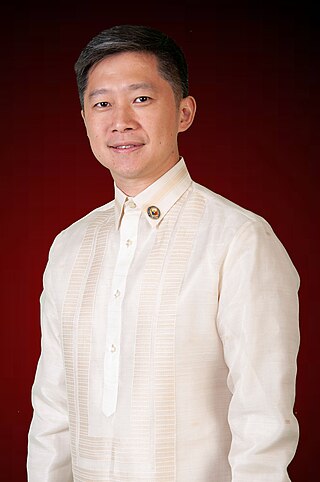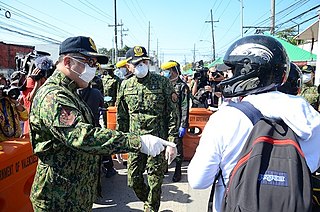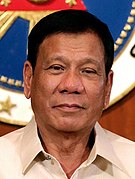
Maria Angelita Ressa is a Filipino and American journalist. She is the co-founder and CEO of Rappler. She previously spent nearly two decades working as a lead investigative reporter in Southeast Asia for CNN. She will become Professor of Professional Practice in the School of International and Public Affairs at Columbia University on July 1, 2024, and will be a Distinguished Fellow at Columbia's new Institute of Global Politics beginning in the fall of 2023.

This article covers the history of the current Philippine republican state following the 1986 People Power Revolution, known as the Fifth Philippine Republic.

Rodrigo Roa Duterte, also known as Digong, Rody, and by the initials DU30 and PRRD, is a Filipino lawyer and politician who served as the 16th president of the Philippines from 2016 to 2022. He is the chairperson of PDP–Laban, the ruling political party in the Philippines during his presidency. Duterte is the first president of the Philippines to be from Mindanao, and is the oldest person to assume office, beginning his term at age 71.

Alan Peter Schramm Cayetano is a Filipino lawyer and diplomat serving as a Senator since 2022 and previously from 2007 to 2017. He was the Senate Minority Leader from 2010 to 2013, and later Senate Majority Leader from 2013 to 2016. He also served as the Representative of Taguig–Pateros from 1998 to 2007 and from 2019 to 2022 and was the Speaker of the House of Representatives from 2019 until his resignation in 2020. He also served as the Secretary of Foreign Affairs from 2017 to 2018 in the cabinet of President Rodrigo Duterte, after unsuccessfully running for vice president in the 2016 elections as Duterte's running mate.

Francisco Moreno Domagoso, also known as Isko Moreno Domagoso or simply Isko Moreno, is a Filipino politician, actor, host and entrepreneur who served as the 27th Mayor of Manila, the capital city of the Philippines, from 2019 to 2022. Before entering politics, Moreno first gained notability as an actor and television personality.

Sara Zimmerman Duterte-Carpio, commonly known as Inday Sara, is a Filipino lawyer and politician who is the 15th and current vice president of the Philippines. She is the third female vice president, the third vice president to come from Mindanao, and the youngest vice president in Philippine history. Duterte is also the secretary of education, holding the post in a concurrent capacity. A daughter of 16th president Rodrigo Duterte, she previously served as the mayor of Davao City from 2016 to 2022, and from 2010 to 2013. She was also Davao City's vice mayor from 2007 to 2010.

Rodrigo Duterte's six-year tenure as the 16th President of the Philippines began on June 30, 2016, succeeding Benigno Aquino III. He was the first president from Mindanao, the first president to have worked in all three branches of government, and the oldest to be elected. He won the election amid growing frustration with post-EDSA governance that favored elites over ordinary Filipinos. His tenure ended on June 30, 2022.

Christopher Lawrence "Bong" Tesoro Go is a Filipino politician serving as a senator since 2019. He previously served in the Cabinet of President Rodrigo Duterte as Special Assistant to the President and Head of the Presidential Management Staff from June 2016 to October 2018. Go has served as the personal aide and special assistant to Duterte since 1998, back when the latter was still mayor of Davao City.

Protests against Former President Rodrigo Duterte escalated on November 18, 2016, following Duterte's support of the burial of the late president Ferdinand Marcos. These series of protests are mostly conducted by progressive groups and other opposing figures mainly due to the ongoing war on drugs, the declaration of martial law in Mindanao, and employment issues such as contractual terms being applied by companies and inflation which occurred due to the passage of the Tax Reform for Acceleration and Inclusion Law. Other causes of the protests include the government's response to the COVID-19 pandemic in the country, the passage of the Anti-Terrorism Act of 2020, and the shutdown and franchise denial of ABS-CBN.

The following is a timeline of protests against Rodrigo Duterte, the 16th President of the Philippines, and his policies. Issues were addressed in the protests including the war on drugs, employment issues, anti-terror law, and the government's response to the COVID-19 pandemic.
2019 in the Philippines details events of note that have occurred in the Philippines in 2019.

Leni Robredo, the 14th Vice President of the Philippines, has held various foreign, domestic, economic, and social positions over the course of her career. She has supported women's rights and women empowerment, human rights, ending endo contractualization, and policies that are pro-poor. As the chairperson of the Liberal Party during her vice presidency, Robredo was the leader of the opposition against President Rodrigo Duterte, taking positions that are contrary to that of the Duterte administration's policies, opposing federalism and charter change, the reimposition of the death penalty, warmer relations with China, and the war on drugs.
The water crisis in Metro Manila, Philippines is the ongoing crisis that affected most of the households with a water interruption. The crisis usually occurs in dry season from March to May. The water suppliers, Manila Water and Maynilad, held responsibility for the crisis.

Eric Go Yap is a Filipino politician serving as the Representative for Benguet's lone congressional district since 2022, and was the district's legislative caretaker from January 2020 until he was elected in his own right. He was a party-list representative for ACT-CIS from 2019 to 2022, and is the chairman of the House Committee on Appropriations since March 2020.
2020 in the Philippines details events of note that have occurred in the Philippines in 2020. The year is largely defined by the COVID-19 pandemic that caused the national economy to go into recession would continued until the state of public health emergency was lifted in the country on July 22, 2023.

The enhanced community quarantine in Luzon was a series of stay-at-home orders and cordon sanitaire measures implemented by the Inter-Agency Task Force for the Management of Emerging Infectious Diseases (IATF-EID) on the island of Luzon and its associated islands. It is part of the COVID-19 community quarantines in the Philippines, a larger scale of COVID-19 containment measures with varying degrees of strictness. The "enhanced community quarantine" (ECQ) is the strictest of these measures and is effectively a total lockdown.

The renewal of the congressional franchise of the Philippine media network ABS-CBN to continue broadcasting was a dispute between the administration of President Rodrigo Duterte and the media conglomerate arising on the terms and conditions of the franchise renewal agreement. Amid the controversy, the Congress of the Philippines, country's legislature, was unable to renew the franchise before its expiration date. The congressional franchise expired on May 4, 2020, as the Philippines was dealing with the effects of the COVID-19 pandemic and the enhanced community quarantine in Luzon. The next day, exercising constitutional powers, the National Telecommunications Commission (NTC) then issued a cease-and-desist order demanding ABS-CBN to cease all of its free TV and radio broadcasting immediately. ABS-CBN complied with the government order and shut down all of its radio stations and free television channels later that day. On June 30, 2020, the NTC released two alias cease-and-desist orders against ABS-CBN TV Plus and Sky Direct.

Vivencio "Vince" Bringas Dizon is a Filipino economist, consultant and political aide who previously served as president and CEO of the Bases Conversion and Development Authority. He also served as President Rodrigo Duterte's Adviser on Flagship Programs and Projects and as Deputy Chief Implementer of the National Action Plan Against COVID-19.

The Build! Build! Build! Infrastructure Program (BBB) was the infrastructure program of the administration of Rodrigo Duterte, the 16th president of the Philippines. A key component of his socioeconomic policy, the program aimed to reduce poverty, encourage economic growth and reduce congestion in Metro Manila, and address the country's infrastructure gap. Launched on April 18, 2017, the program also included the continuation of 44 infrastructure projects under previous administrations.




















